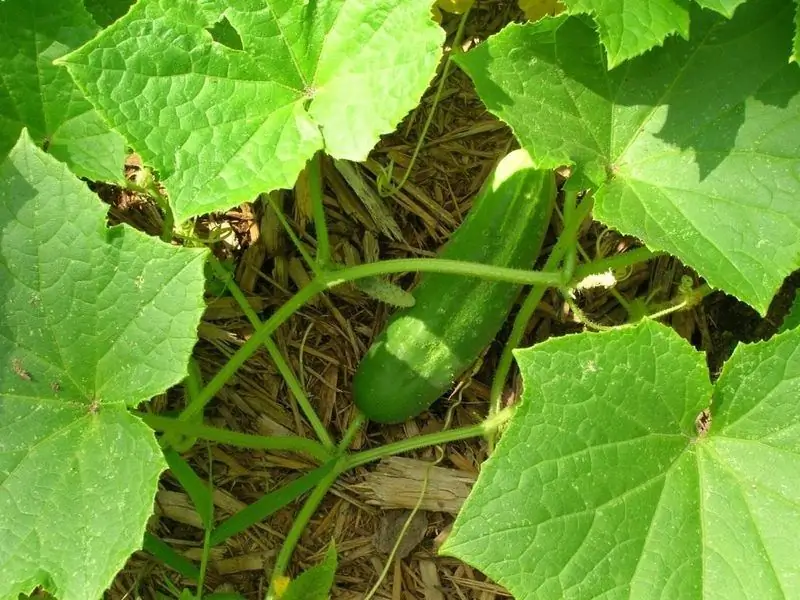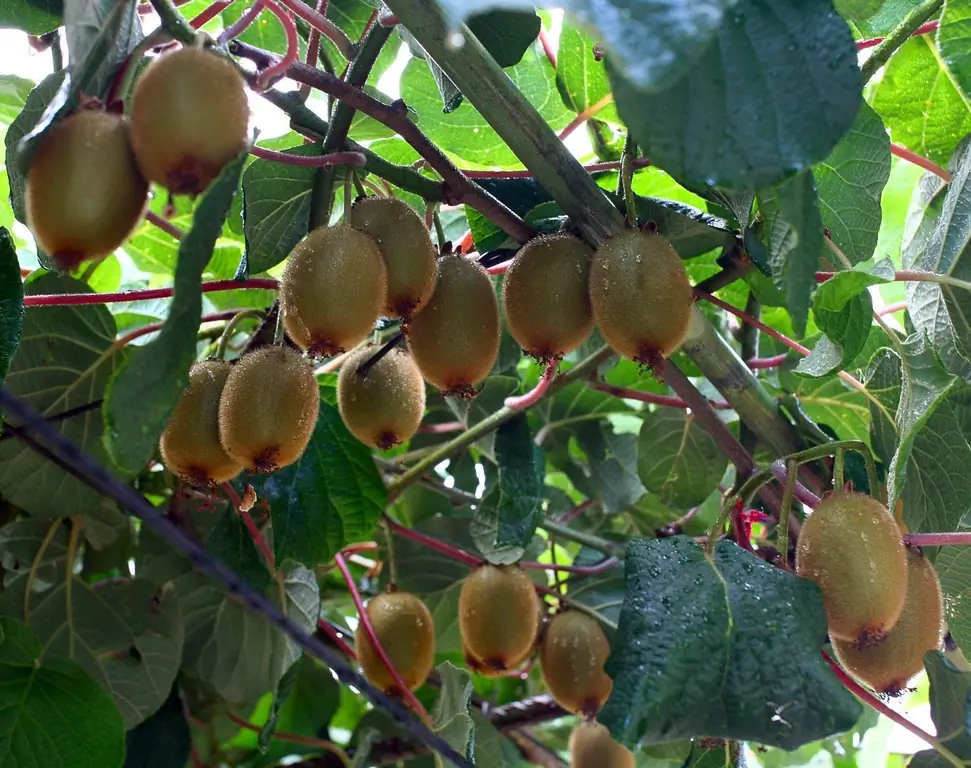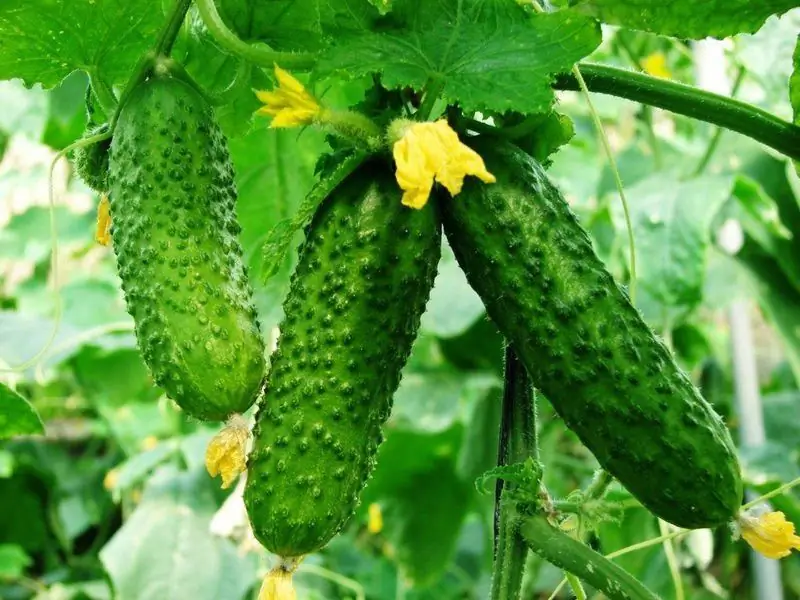
Table of contents:
- Author Bailey Albertson [email protected].
- Public 2023-12-17 12:53.
- Last modified 2025-06-01 07:32.
All the rules for growing cucumbers in the open field

Cucumbers are a fairly early ripening and productive crop that grows well in the open field even in Siberia. They should not take up precious space in the greenhouse or build greenhouses. To get a good harvest, it is enough to choose the right variety and place for the garden, and then provide proper care.
Content
- 1 Varieties and hybrids of cucumbers for open ground
-
2 Landing rules
- 2.1 Video: cucumbers in bags
-
2.2 Sowing with seeds
2.2.1 Video: preparing the garden and sowing cucumbers
-
2.3 Planting seedlings
2.3.1 Video: planting cucumbers in open ground
-
3 Features of caring for cucumbers in the open field
- 3.1 Favorable temperature
-
3.2 Watering
3.2.1 Video: how to properly water cucumbers
- 3.3 Top dressing
-
3.4 Protection against disease
3.4.1 Video: how to protect cucumbers from diseases with serum and iodine
- 3.5 Formation of hybrids
-
3.6 Formation of varieties
3.6.1 Video: how cucumber varieties are formed and grown
- 3.7 Garter cucumbers
- 4 Harvesting and processing
Varieties and hybrids of cucumbers for open ground
Unlike greenhouses, you can grow any cucumber in the open field: both old bee-pollinated varieties and modern parthenocarpic hybrids that do not require pollinators. It is most optimal to choose early cucumbers with long-term fruiting, disease-resistant and unfavorable weather conditions. For example:
-
Cold-hardy and Emerald Stream are two different hybrids from the same category - Chinese cucumbers bred by the Sedek agricultural firm. The yield in the open field is simply off scale, 2-3 bushes are enough to feed a family of four and neighbors. But they have a ripening period of about 50 days; in regions with a short summer, it is better to plant seedlings on a garden bed.

Cucumber Emerald Stream Chinese cucumber Emerald Stream is so named for its abundant and prolonged fruiting until the very frost
-
Sonata is a very fruitful, heat and disease resistant bee-pollinated hybrid. It is grown commercially by farmers. Zelentsi are large-lumpy, standard size (8-10 cm), never bitter, well suited for whole-fruit canning.

Cucumber Sonata The Dutch Sonata cucumber is grown commercially
-
Connie is loved by summer residents, grown for many years in a row and every season they enjoy good yields. Cucumbers are not large, covered with small tubercles and frequent spines.

Connie's Cucumbers Connie cucumbers with small tubercles, completely covered with spines, are excellent for pickling
-
Graceful - an old bee-pollinated variety, a favorite of experienced gardeners. The cucumber grows in a bush, and not in one lash, like hybrids, it has male and female flowers. The graceful one is well suited for growing without a garter.

Cucumber Graceful Beautiful, perfectly shaped fruits of the Graceful are tasty and fragrant fresh and canned
-
Mother-in-law and Zyatok are modern hybrids from the Gavrish company, it happens that they are packed in one package. Both "parthenocarpics" grow well both in the greenhouse and in the open garden. The cucumbers are lumpy, white-thorny, only in Mother-in-law they are larger, but in the Son-in-law, the yield is higher.

Cucumbers Mother-in-law and Zyatok Seeds of varieties Mother-in-law and Zyatek inside the package are in a separate package
Be sure to choose varieties and hybrids that are adapted to your climate. There is no information about the regionalization region on the seed packages, but it is available on the Internet, for example, on the website of the State Variety Commission, in the State Register.
Landing rules
Cucumbers are a thermophilic culture, they stop growing even at 8 ° C, and if this temperature lasts for several days, they die. It is necessary to plant plants in open ground when all frosts end and it will be warm even at night (15 ° C and above).
In addition to heat, cucumbers love a lot of light and do not tolerate winds well. The best place for a garden will be a plot on the south side of the house, barn or fence. This arrangement is especially important if it is planned to tie the lashes vertically to the trellises. In the middle of the garden, they will be strongly flapped by the wind, in addition, cucumbers will create a strong shadow for nearby plantings.

A wall of cucumbers in the middle of the garden will create a thick shadow
Good precursors to cucumbers:
- cabbage,
- tomatoes,
- potatoes,
- legumes,
- greens.
You cannot plant them every year in the same place, as well as after pumpkins, squash and zucchini.
Having chosen the site and timing, proceed with soil preparation. For 1 m² you need to make:
- 2 buckets of humus,
- 0.5 l of wood ash.
Prepare the garden bed at least 2-3 days before planting. If the soil is dry, pour it with clean water or with the addition of potassium permanganate to prevent disease (1 g per 1 liter of water).
Open field cucumbers can grow not only in ordinary beds, but also in barrels, on compost heaps, in bags, buckets, tires, boxes. Typically, such containers are used when:
- there is little space on the site;
- there is still a lot of untreated virgin soil and cucumber containers are placed on it;
- the site is damp, flooded with melt and rainwater.
Video: cucumbers in bags
Sowing with seeds
Sprout the seeds before sowing, but if they are covered with colored glaze, then sow dry. The planting pattern or density is indicated on the package. If the cucumbers grow in one lash, they give few stepsons, tied to a trellis, then they are sown denser (3-4 plants per 1 m²), and strongly branched, grown in spreading - less often (2-3 per 1 m²).
By the time of landing, the ground should warm up to 15 ° C and above. Sow the seeds into damp ground, to a depth of 2-3 cm. To prevent the soil from drying out, cover it with a small layer of light mulch (1-2 cm) - old sawdust, peat. Never cover with foil or glass for several days! Shoots can appear in your absence, during the day under such a shelter they will burn.
Video: preparing the garden and sowing cucumbers
Planting seedlings
We usually buy or grow seedlings ourselves. In both cases, its optimal age at the time of planting in the ground is 25-35 days. By this time, the cucumbers have already acquired 3-5 true leaves. Seedlings should be with a closed root system, that is, in pots with soil. Open roots are easily injured, plants usually die or get sick for so long and take root that one cannot expect a good harvest from them.

Cucumber seedlings should be in a glass, and its root should be in an undisturbed clod of earth
Transplant the cucumbers from the pots very carefully, by transshipment, that is, with a lump of earth, without violating its integrity:
- Make holes according to the pattern for your variety or hybrid. Their size should correspond to the size of the pots and even be larger if the seedlings are elongated.
- Fill the wells with warm rainwater.
- When the water is absorbed, remove the seedlings from the pots and place them in the holes. Expand the extended one to the cotyledonous leaves.
- Fill the holes, tamp the earth, water it again and mulch, or at least sprinkle it with dry earth on top so that a crust does not form and the roots can breathe.
Video: planting cucumbers in open ground
Plant cucumber seedlings in the evening, in cloudy weather. If it's hot, shade the cucumbers for the first 2-3 days.
I usually sow cucumbers with seeds, but once the seedlings appeared thickly, and it was a pity to pull out and throw away. I made a hole in the middle of the garden about 50 cm in diameter and transplanted extra sprouts into it. Only 4 bushes. They had only one more real sheet on them. The weather was hot, the settlers began to fade and turn yellow. I looked at the martyrs one day and decided to build a tent for them. I stuck 4 pegs around the perimeter of the hole and pulled a piece of fabric between them. My cucumbers came to life in the shade, started growing and quickly got out from under the saving, but already unnecessary shelter.
Features of caring for cucumbers in the open field
Cucumbers spoil us with a harvest every 2 days. With the same frequency, you will have to take care of them.
Favorable temperature
Cucumbers develop well and set fruit at 24-28 ° C during the day and 18-22 ° C at night. In the heat above 30 ° C, the bushes age quickly, stop bearing fruit prematurely, and dry out. In the cool, on the contrary, all processes proceed slowly, flowering does not occur, or there are few flowers, the ovaries barely grow. In both cases, the yield falls.
Turn on the sprinkler to lower the temperature. It is impossible to pour cold water over the leaves, but you can irrigate with small drops, which are heated on the fly in contact with hot air.

Cucumbers in the heat love water treatments
It is also necessary to fight with the coolness and the difference in day and night temperatures. Cover the cucumbers during a cold snap, and also use water-filled plastic bottles, large stones, bricks. Spread these heat accumulators all over the bed under the bushes. They will heat up during the day and give off heat at night.

The bottle is lying for a reason, it's a mini cucumber battery
Watering
Cucumbers have a superficial root system. Bushes cannot extract water independently from deep soil layers, therefore, in terms of irrigation, they are entirely dependent on us. The soil must be kept constantly moist, not allowing even the top layer to dry out. Do not loosen the soil after watering, you can damage the roots, it is better to put a layer of humus, compost or dry grass on top. Then you will have to water less often.
I live in South-West Siberia and even in our not very sunny region I water cucumbers every day, of course, skipping rainy periods. I pour one watering can onto a 1x2 m garden bed, when the cucumbers are still small, they are only building up whips, and two - under the already fruiting bushes.
If you grow in a spread, then water the ground not only near the base of the bush, but also all over which the lashes have spread. The roots spread underground in the same way as their stems are above it. In this case, you will have to pour over the leaves. Choose the time for watering so that the bushes have time to dry out before the night coolness.
Video: how to properly water cucumbers
It is also dangerous to flood the ground under the cucumbers. Remember that the soil must be loose and allow moisture to flow to the roots. And in the flooded soil, water fills all the spaces between the lumps of earth, displacing oxygen from there.
Top dressing
Cucumbers are fertilized with organic infusions, yeast, mineral and organic fertilizers, ash. But each top dressing must be applied in due time:
-
At the beginning of the growing season before flowering - nitrogen. Infusions of nettle (1: 5 with water), droppings (1:20), mullein (1:10), yeast (10 g dry per 3 liters of warm water, when fermented, add up to 10 liters and water) are well suited.

Nettle infusion The most popular natural supplement is nettle infusion
-
During the period of mass flowering and fruiting - complex mixtures containing potassium and trace elements. This includes wood ash (shake and pour a glass of 10 liters of water), as well as purchased fertilizers for cucumbers or vegetables: Fertika, Agricola, BioHumus, BioMaster, etc. Each has its own instructions.

fertilizer for cucumbers During fruiting, give up self-activity, cucumbers need special balanced feeding
Apply nutrient mixtures every week at a rate of 5 liters per 1 m². It is better not to use mineral fertilizers (urea, ammonium nitrate, superphosphate, etc.), give preference to natural ones.
In addition, spraying on the leaves is encouraged:
-
Ovary or Bud during flowering for better fruiting. Such treatments are especially relevant in unfavorable weather, when the ovaries turn yellow and crumble.

Ovary preparation The drug Ovary promotes better fruit formation
-
Epin, Energen, Novosil and other stimulants, if you see that cucumbers need an ambulance, for example, they began to turn yellow due to cold or heat, they were attacked by pests or signs of disease appeared. Stimulants will not cure, but they will increase immunity, the bushes will suffer less and recover faster.

Energen Extra Energen Extra is sold in capsules, so it is convenient to dilute it in any required amount of water
Disease protection
It is better to prevent diseases than to cure them, because it is impossible to spray cucumbers with fungicides during fruiting, but it lasts all summer continuously. For prevention:
- Once a week, add the biological product Fitosporin (2 tablespoons of paste concentrate to 10 liters of water) to the irrigation water. The same solution can be sprayed over the leaves.
- Tear off the bottom, touching and yellowing leaves regularly.
- When harvesting, try to crush the whips and leaves less, because any crack is an open gate for the penetration of pathogenic fungi and viruses.
- Remove from the bushes all fruits that are ready for picking and especially overgrown, crooked, rotten, damaged by slugs. This increases the yield and removes the foci of infection.
For many years in a row I have been growing cucumbers on my site and, by my standards, they do not get sick. Of course, there are specks on the lower leaves, but in general, the bushes look vigorous, bear fruit well all season. At the end of summer, because of the cold nights, the whips begin to die off. But I’m even happy about that: so many cucumbers have been harvested over the summer that it’s time to pull out the bushes and take them into the compost. I do not spray cucumbers with folk remedies: water with iodine, serum, etc. I try to maintain their health with good care: I water them, feed them regularly, keep from the cold, for the last 2-3 years I tie them up, I actively use stimulants, Fitosporin sometimes.
Video: how to protect cucumbers from diseases with serum and iodine
Formation of hybrids
Hybrids and varieties are shaped differently. If there is an F1 marking next to the name, then this is a hybrid. Do this with him:
- Blind the sinuses of the first 3-5 leaves, that is, pluck out everything that grows from them: shoots, buds, ovaries.
- Leave the flowers and ovaries above, but with the stepsons (lateral shoots) you can do different things, for example, remove the whole, pinch them over the second, third or fifth leaf.
Usually, recommendations for shaping are given on seed bags. We ourselves must learn the principle that in hybrids cucumbers are tied both on the main stem and on the stepchildren, and in each axil of the leaf. And if a hybrid with a bunch ovary, then there will be several of them in each sinus.

Hybrid formation patterns are usually indicated on the packaging.
The more cucumbers you need, the more and longer you leave the stepsons. Of course, for the life of a highly branched bush, a long and warm summer will be required, as well as more intensive watering and feeding.
Formation of varieties
If there is no F1 marking, the package says that this is a bee-pollinated variety, then you need to form it in a completely different way:
- The sinuses of the lower five leaves, on the contrary, must not be touched! Lateral fruiting whips will grow from them.
- Pinch the main stem over the fifth leaf. Only male flowers bloom on it - barren flowers.
The difference between hybrids and varieties is that the former have all or predominantly all the flowers are female, that is, with ovaries, while the varieties have male ones on the main stem and female ones on the lateral shoots. Those barren flowers that remain in the axils of the lower leaves are enough for pollination of both their own and neighboring female flowers. Without barren flowers, there will be no cucumbers on the varieties.
Video: how cucumber varieties are formed and grown
To be honest, just a couple of years ago I learned that cucumbers need to be shaped somehow. But even now I do not form any hybrids or varieties. I am not a farmer, I do not strive for high and early productivity for a good profit. What gives 5-6 bushes without any shaping is enough for our family. It doesn't matter to me that a hybrid with blinded lower sinuses starts bearing fruit 5 days earlier, I can plant an earlier one. I pinch the extra lashes when they begin to climb, where they were not invited, without counting a certain number of leaves. I don't pinch the varieties either, I grow them without unnecessary troubles. My opinion: cucumbers themselves know how to grow them, unnecessary pinches without understanding their structure can only harm. But if you want phenomenal yields, then the shaping guidelines are worth listening to. By the way, the idea came up:if cucumbers grow on any stem and shoot in hybrids, then they can be formed into 2-3 stems (plus stepchildren on each), as long as the weather allows and fertilizers are applied.
Garter cucumber
Of course, it is convenient to pick cucumbers while standing by the bush, and not crawling through the beds, as is the case when growing in the open. But vertical cultivation is not always appropriate in the open field. In regions with hot, dry summers, the whips will feel much more comfortable, lying on the ground, and tied up and placed under hot dry winds will burn.

Growing in spread also has its advantages: the wind is not so terrible, in the heat it is cooler near the ground
It is not difficult to build a trellis in the open field. There are two most common options:
-
Drive two posts (wooden or metal pipes) along the edges of the bed. Fasten the crossbar on top and tie the ropes to it according to the number of lashes. The stems need to be periodically reeled up to such a trellis, but they themselves will cling to the ropes with antennae.

Trellis for cucumbers in the open field A simple version of the trellis - posts, rungs and ropes for garters
-
Pull any mesh (nylon, plastic, metal) between two pillars driven into the ground. The cucumbers themselves will braid it and turn it into a green wall.

Cucumbers on an inclined trellis Sly trellis made of mesh - with such a garter, all the fruits hang down, you do not need to look for them among the tops
I once managed to plant cucumbers in a barrel next to a young, but already strong cherry. The scourges reached her and clung to the branches. They did not strangle the cherry, the cucumbers do not grow so much, but collecting green leaves from the tree was not only convenient, but also fun.
Harvesting and processing
Cucumber fruits are edible at any stage of growth. You can pick small 3-4 cm long for pickles and grown ones - for pickling, salads, canning. The more often you harvest, the more the bush will tie new cucumbers, this is especially true for indeterminate hybrids with unlimited growth. On varieties, you can leave one seed cucumber, on hybrids the seeds rarely ripen, they are usually underdeveloped, not viable.

Do not keep cucumbers on bushes to such a degree of maturity, they are only suitable for seeds
When visiting the dacha once a week, you can not even dream of the yield declared on the package of seeds. The bush will pour and ripen the already existing fruits, and it is extremely reluctant to tie young ones. Therefore, even if now you do not need as many cucumbers as they have grown, it is better to collect and take the extra ones into the compost. Then new greens will constantly grow in your garden.
The cucumber is very responsive to care. Every day he thanks for the care: first with active growth, and then with fragrant greens. Agricultural practices during cultivation are the most common, but they need to be performed almost every day.
Recommended:
Growing Cucumbers On A Trellis In The Open Field - Rules + Photos And Videos

Features of growing cucumbers on a trellis in the open field. Construction and installation of trellises, preparation for planting cucumbers, rules for planting in open ground
How To Grow Kiwi (at Home From Seeds, Seeds, Etc.) + Video And Photos

Step by step instructions for growing kiwi at home. Growing from seeds and seeds, taking care of seedlings and plants during the growth period
How To Feed Cucumbers In The Open Field If The Leaves Turn Yellow And In Other Cases

Top dressing with slow growth of cucumbers. How to fertilize if the leaves turn yellow. How to feed in a polycarbonate greenhouse. Feeding with yeast. Instructions. Video
Gladioli In The Open Field: Planting And Care, When To Plant And Not Only

Advice on growing, caring for gladioli, collecting and storing bulbs - adults and children. Tuber planting schemes, variety selection
How To Tie Up Cucumbers In The Greenhouse And Open Field

What are the benefits of a garter of cucumbers, what problems it relieves. Universal rules. Habitual and non-standard ways of tying + photos, videos
